The Huawei Ascend Mate 7 Review
by Andrei Frumusanu on December 2, 2014 8:00 AM EST- Posted in
- Smartphones
- Huawei
- Mobile
- Ascend Mate 7
- HiSilicon
Display
With the Ascend Mate 7, Huawei introduces a JDI-manufactured IPS-Neo screen. The advantage of the IPS-Neo technology is that it provides better viewing angles and contrast ratio due to a change in the manufacturing process which allows for the the liquid crystal molecules to be uniformly aligned on the glass substrate.
Indeed, the viewing angles of the Mate 7 are much improved and I'd say it's one of the best in terms of LCD displays. Contrast ratio has also considerably gone up as we'll see in a bit.
The Mate 7 display offers lots of promise, but let's see if it holds up with our objective measurement tests. We use an X-Rite i1Pro 2 as our measurement hardware, in conjunction with SpectraCal's CalMAN software suite and our own workflow to be able to get an accurate display characterization.

The Mate 7 ends up at 484cd/m² in terms of brightness. It's plenty of bright for all but the most sunny days. Only direct sunlight reflectance may pose an issue.
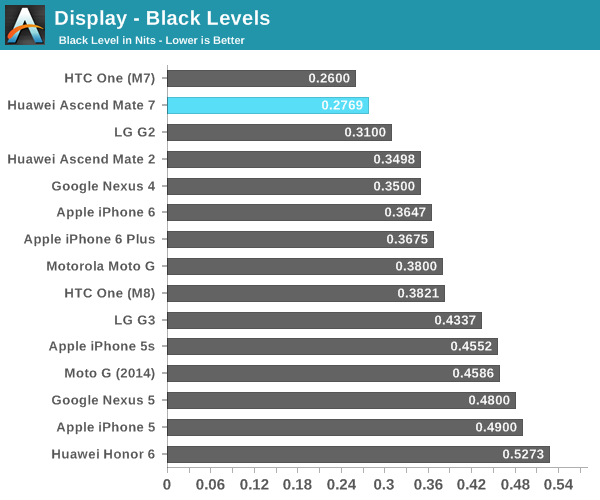
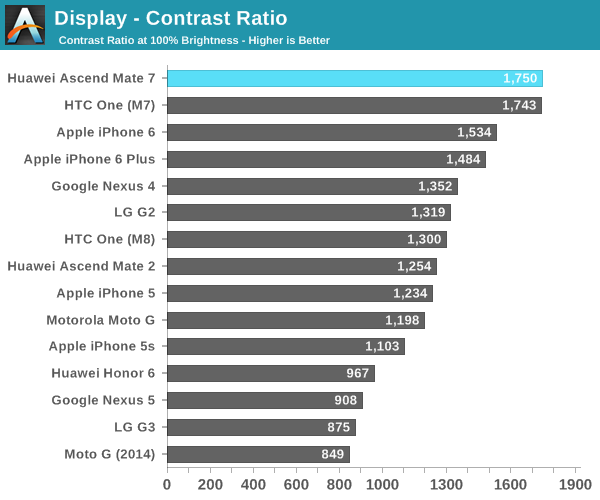
In the black levels and respectively the contrast ratio is where we see the IPS-Neo screen perform extremely well. For an LCD screen, this is one of the deepest blacks I've come to meet in a device. The HTC One M7 seems to be the only other device to come near it, but that was at a lower brightness point with dynamic contrast.
The Mate 7 is able to achieve a 1750:1 contrast ratio, putting it at the top of the LCD pack. Only AMOLED displays are able to outperform this figure due to their ability to avoid any light emission on a per-pixel level.
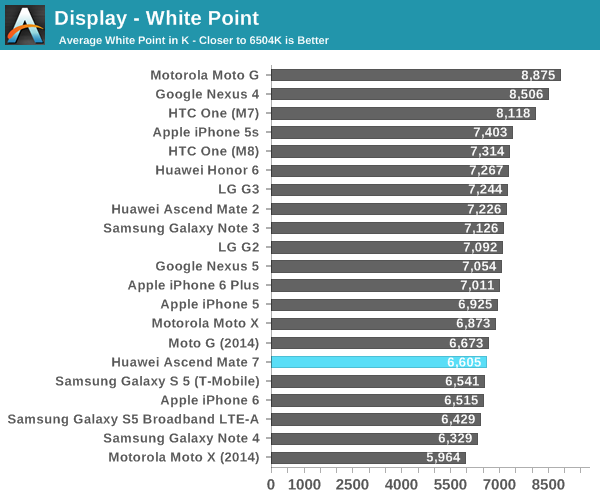
In terms of colour temperature, the Mate 7 performs again quite well while hitting 6605K. This time Huawei seems to have aimed for 6500K instead of colder colours as on the Honor 6. If you still prefer the more colder and blue-dominated whites, Huawei as retained the colour temperature slider under the display settings which allows you to adjust the tone of the display to your own preference.
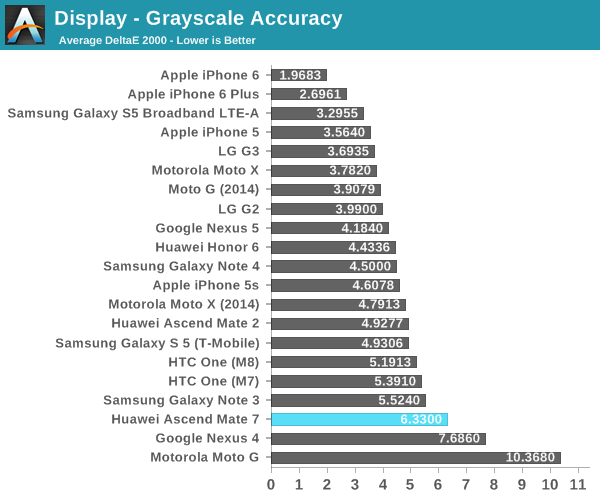
While the colour temperature figure seems to be quite good, under further investigation we see that there's a problem. Our grayscale accuracy test shows that there's much too much green at all grayscale levels. In fact, this is actually clearly visible on the device as we see a slight green tint. Gamma reaches an acceptable 2.11, still a bit off a perfect 2.2. Due to the green tint of the device the grayscale dE2000 ends up at 6.33, much worse than any device released in the last 18 months, and above the average perceivable threshold of 5.
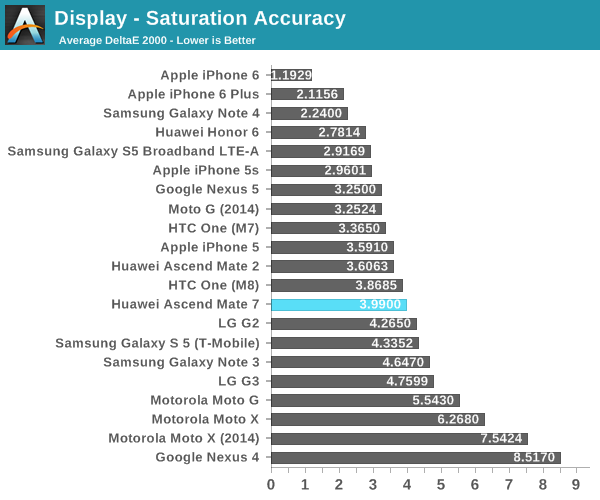
Looking at the saturation accuracy graph, we see again an overabundance of green. It looks like the whole spectrum is pulled slightly towards green, which results in a whole offset of all measured colourpoints. This is a pity as the display seemed to be quite well calibrated in terms of saturation compression. The end result is that we end up with a meager dE2000 of 3.99. While this is much less worse than the grayscale measurements, it's not too bad, for example, it performs better than this year's G3.

Our Gretag MacBeth test is a measurement of accuracy of several commonly used colours. The Mate 7 ends up with a respectable dE2000 of 3.88 here. We again find that the score is merely thwarted by the green-shift of the display, prohibiting this display to enter the group of outright excellently calibrated devices such Samsung's and Apple's newest models.













72 Comments
View All Comments
MantasPakenas - Thursday, December 4, 2014 - link
Wow. I guess this is as direct confirmation that Sony hasn't provided them a device for review as we can get. I just wonder if they've also been asked for one specifically, which they probably were.No wonder Sony continues to underperform with their handset business despite making some great devices. Their marketing can't be excused for not having a review at Anandtech as soon NDA lifts.
Andrei Frumusanu - Thursday, December 4, 2014 - link
I've tried reaching out to Sony as being one of the newer European editors (Sony has a much stronger presence here) but sadly they haven't gotten back to me in 3 months.It's a pity.
Dribble - Tuesday, December 2, 2014 - link
/me looks for nexus 9 review - nope still not hereIt's not just Sony!
Ethos Evoss - Wednesday, December 17, 2014 - link
I have feeling they picking phones which they wants to slag and make crap from..ayejay_nz - Tuesday, December 2, 2014 - link
I second this, thanks a lot for the review.I was hoping this device would provide similar battery performance to the Mate 2, alas : [
Might have to get a 6+, however the fact that the Lightning SD Card Adapter doesn't work with it is extremely frustrating. A $750 - $950 smart phone that can't download photos quickly because of some stupid software switch that makes the adapter incompatible, sigh. May have to use a WiFi SD card or Reader : [
Ethos Evoss - Saturday, December 6, 2014 - link
That we ALWAYS know then u are wisiting anadtech :D THE MOST WEIRD website on the planet..I bet everybody there has iiiphhhonees 6 and pluses there.. and they having even sex with them ..@DDD
banks1990 - Tuesday, December 2, 2014 - link
"The dimensions figure at 139.6 x 69.7 x 7.9mm"Almost the same size of a Huawei Honor 6 eh?
bernstein - Tuesday, December 2, 2014 - link
interesting! this phone is smaller than its screen, which measures ~73x130mm.obviously its completely wrong... the mate 7 measures 157 x 81 x 7.9 mm :)
Andrei Frumusanu - Tuesday, December 2, 2014 - link
My apologies - yes I initially started off the same table for the specs.tipoo - Tuesday, December 2, 2014 - link
That much throttling with that little performance is...Kind of impressive, in a way? Well, that all turns me off from this phone anyway.